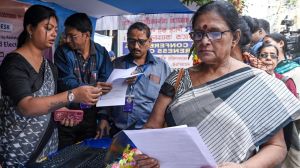Maya, Modi and Azad: Dalit Politics in the Time of Hindutva is an engaging account of the increasing right-wing shift in Dalit politics, especially in UP
The well-researched book by Sudha Pai and Sajjan Kumar helps us overcome oversimplification and dominance of activist knowledge in understanding Dalit-Bahujan electoral and democratic politics.
 Maya, Modi, Azad: Dalit Politics in the Time of Hindutva, Sudha Pai and Sajjan Kumar, Harper Collins, 336 pages, Rs 599. (Source: Amazon.in)
Maya, Modi, Azad: Dalit Politics in the Time of Hindutva, Sudha Pai and Sajjan Kumar, Harper Collins, 336 pages, Rs 599. (Source: Amazon.in)I usually avoid reviewing books, but I readily agreed to review Maya, Modi and Azad: Dalit Politics in the Time of Hindutva for two reasons. First, it is led by credible political scientists. Second, both the authors — Pai and Sajjan Kumar – have tried their best to document the various streams and multiple movements of Dalit-Bahujan mobilisations and politics in north India, especially in Uttar Pradesh (UP). We usually talk about the present and past of any socio-political phenomena, but this book provides some insightful reflections on the future of Dalit politics in India, especially in the north.
As we know, the Dalit community is not homogeneous. So, their political sense is also not unidirectional, as usually propagated by Western academia, a few political leaders and some socio-political activists. In fact, Dalits as a homogeneous political group is a decades-old stereotype that needs correction and update in the light of new changes happening in Indian politics.
In fact, a rapid shift is taking place in the social and political formations and reformations of communities in India due to various developmental initiatives taken by the state. These shifts are marking ground for change in the ongoing political mobilisations of communities, especially of those who are marginalised. On the one hand, these shifts are making Indian politics creative and interesting. It is also rupturing the ‘over-claimed homogeneity’ of mobilisation of the marginalised by a group of academicians, political activists and politicians and making it multi-directional. This book tries to understand these multidirectional movements and exposes the politics of categories that come from the top and captures our social imagination.
The title of the book represents Maya, Modi and Chandrashekhar as three metaphors that are pulling in three different directions of Dalit-Bahujan political mobilisations in India. But they also overlap and criss-cross each other, creating an interesting history of contemporary Dalit-Bahujan political consciousness. This book helps us overcome oversimplification and dominance of activist knowledge in understanding Dalit-Bahujan electoral and democratic politics.
Another factor that caused upheaval in the settled nature of caste mobilisations is the rise of Hindutva, which needs to be understood through in-depth fieldwork. This book gives a sufficient response to such research requirements. The rising Hindutva aspirations among marginal communities, alongside growing developmental aspirations, jumbled the arithmetic of caste. It evolved a new chemistry which made the Bharatiya Janata Party (BJP) one of the assertive claimants of Dalit-Bahujan votes. This book focuses on these various recent shifts in Dalit politics, with a special focus on Uttar Pradesh. In the realm of Dalit political assertion, Uttar Pradesh has witnessed the electoral success of Mayawati and then a shift of Dalit votes towards the BJP under the umbrella of soft Hindutva. The book also documents the political emergence of Chandrashekar Aazad, his Bhim Army, and the recently established Azad Samaj Party (ASP). It captures how in UP, in the era of right-wing political assertion, there are small parties standing up for Dalit causes and trying to sustain Ambedkarite politics. Starting with the trajectory of the decline of the Dalit movement with the weakening of Congress and the fragmentation of Dalits into various groups after the decline of BSP, it also captures how Dalit discourse unfolded and responded to changing socio-political discourses over a period of time.
The BSP’s identity politics had instilled a sense of self-respect among Dalits. Through the shift of the BSP from a radical movement to a political party with new strategies to capture power, the book also captures the present crisis of identity politics in Uttar Pradesh. This book goes beyond the dominant discourses and existing academic writings to uncover the decline of the BSP, and the weakening of identity politics, with the move of a section of Dalits groups under the Hindutva fold and their strategic tactical and ideological positions.
The book also stands out for its wide coverage of the changing political behaviour of Dalits, their shift towards soft Hindutva, and the impact of welfare measures like Ujjwala, Direct Benefit Transfers (DBT), and other welfare schemes on their decisions. The authors have also delved into BJP’s strategies of addressing multiple caste groups through extensive fieldwork in Uttar Pradesh. It tries to understand the making of labharthi-s and the impact of Pradhan Mantri Garib Kalyan Yojana, which sometimes weaken caste-based mobilisations of poor communities.
The authors have rightly observed that UP is witnessing two contrasting trends in Dalit mobilisation — political protest for Dalit rights but also electoral preference for the right wing. This is an interesting book that explores various small political spaces in societies like UP’s as well as the growing influence of Hindutva in Dalit political mobilisation. While reading the book, a thought that resonated with me constantly was how democratic politics and Hindutva are evolving together without contradicting each other.
The writer is professor, Govind Ballabh Pant Social Science Institute, Allahabad
- 01
- 02
- 03
- 04
- 05






























